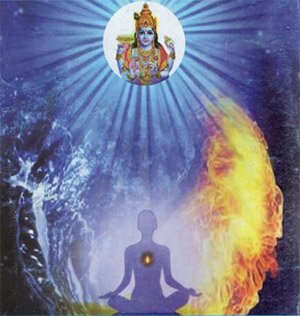Siddhanta Sangraha of Sri Sailacharya
by E. Sowmya Narayanan | 2008 | 30,562 words
Siddhanta Sangraha Chapter 38 (English translation), entitled “nitya vibhuti” as included in the critical edition and study. The Siddhanta Samgraha is a Sanskrit philosophical text dealing with Vishishtadvaita in five hundred Sanskrit verses. It was written by Shri Shailacarya (18th century) and closely follows the philosophy of Vedanta Deshika (13th century).
Chapter 38 - Nitya Vibhūti
384. It has been proved that there is no pramāṇā namely smṛti or recollection resulting from mind. Now it is explained the nitya vibhūti or the eternal abode in the due order.
385. It is defined as the substratum of the pure sattva which is free from the admixture of other two guṇas namely, rajas and tamas.[1] According to Pāñcarātra, the nitya vibhūti is the conscious principle and hence, it is self luminous.
386. Due to the abundance of eternal entities present in it, it is known as nitya vibhūti.
387. Some eternal entities are created by the freewill of the Lord. It is not subject to the transformation pertaining to the time such as birth, old age, death etc.
388. The speciality of the nitya vibhūti is that the released souls (Mukta), if desirous of perceiving the manes, can do so because of their free resolve that is dependent on the Supreme Lord. This free will is not due to Karma and is similar to that of the Supreme Lord. The Lord out of His own saṅkalpa chose for instance, King Daśaratha as His father.[2]
389. As the released souls do not have any contraction in the knowledge at any point of time when they manifest in different forms because of their free will, their form is unmixed with the pure sattva and their knowledge remains uncontracted.
390-391. The Transcendental Lord when the manifest or incarnates in different form, does so along with His Consort Śrī or Lakṣmī who is ever associated with Him in His chest. The forms of Lakṣmī too are, in all the incarnations, is non material (aprākṛta).This has been explained by Śrī Desika in the Śrī Stuti ślokas namely, ‘datte śobhām and its preceding one āpannārthi.[3]
392. The realized souls or yogins know that the divine beatific form of the divine couple which is knowledge and bliss is veiled by māya. This divine form cannot be comprehended by the non-yogin.
393. Though the Six transcendental quantities (śādguṇya [ṣāḍguṇya?]):—jñāna, bala, aiśvarya, vīrya, śakti and tejas are present in the vyūha forms of the Lord, namely, saṅkarṣaṇa, pradhyumna and aniruddha. Only the two qualities are explicit (shine) in each manifestations and the others are not exhibited, though they are present in them. In the first manifestation jñāna and śakti in the second bala and aiśvarya and in the third one vīrya and tejas are explicit and the other guṇas in each are implicit. Only the upāsakas (Spiritual Practitioners) are capable of perceiving these two qualities of vyūha avatāras.
394. It has to be understood that even in the Vibhava incarnations, of the six qualities only some qualtities are explicit.
Footnotes and references:
[1]:
See Nyāya Siddhāñjana, p.236.
[2]:
See Rāmāyaṇa, Balakanda, XV, 30.
[3]:
See Śrīstuti—9, 10, 11.
Conclusion:
 This concludes Nitya Vibhuti according to Vishishtadvaita philosophy explained by Shri Shailacarya. This book follows the model of Vedanta Deshika although the Vishishta Advaita school was originally expounded by Shri Ramanuja. Vishishta-Advaita is one of the various sub-schools of Vedanta which itself represents one of the six orthodox schools of Hindu Philosophy. They highlight the importance of the Upanishads, the Bhagavad Gita and the Brahma Sutras.
This concludes Nitya Vibhuti according to Vishishtadvaita philosophy explained by Shri Shailacarya. This book follows the model of Vedanta Deshika although the Vishishta Advaita school was originally expounded by Shri Ramanuja. Vishishta-Advaita is one of the various sub-schools of Vedanta which itself represents one of the six orthodox schools of Hindu Philosophy. They highlight the importance of the Upanishads, the Bhagavad Gita and the Brahma Sutras.
